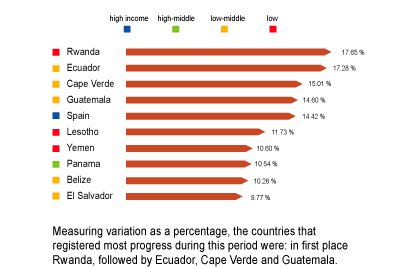The 10 countries with the greatest GEI progress
Income and equity are not directly related
Measuring variation as a percentage, the countries that registered most progress during this period were: in first place Rwanda, followed by Ecuador, Cape Verde and Guatemala
The 10 countries with the greatest GEI progress

|
Country |
Region |
Income |
GEI 2004 - 2007: Percentage variation |
|
Rwanda |
Sub-Saharan Africa |
Low income |
17.65 % |
|
Ecuador |
Latin America and the Caribbean |
Lower-middle income |
17.28 % |
|
Cape Verde |
Sub-Saharan Africa |
Lower-middle income |
15.01 % |
|
Guatemala |
Latin America and the Caribbean |
Lower-middle income |
14.60 % |
|
Spain |
Europa |
High income |
14.42 % |
|
Lesotho |
Sub-Saharan Africa |
Low income |
11.73 % |
|
Yemen |
Middle East and North Africa |
Low income |
10.60 % |
|
Panama |
Latin America and the Caribbean |
Upper-middle income |
10.54 % |
|
Belize |
Latin America and the Caribbean |
Lower-middle income |
10.26 % |
|
El Salvador |
Latin America and the Caribbean |
Lower-middle income |
9.77 % |
Some key area measures for the promotion of gender equity are: education initiatives; gender sensitive finance and budgeting; and affirmative action legislation and policies.
Income and equity are not directly related
Examining the variations in relation to income levels we find that low-income countries have not progressed. However, the differences between countries with high, middle and low-middle incomes are not significant, which confirms that the relation between a country’s income and gender equity is not direct.

